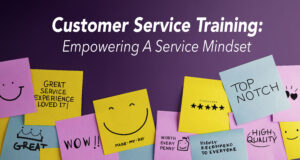The Evolution of The Contact Center Experience

The term “call centers” is quickly become a relic of the past, and for good reason. Customer service today entails far more than just taking inbound calls; it’s now truly omnichannel. In addition to answering phone calls, today’s contact center experience typically requires agents to have responsibility for responding to online live web chat, text chat, email requests, website contact form submissions and even social media posts.
However, while customers expect to have this flexibility to engage with brands on their terms, phone and voice remain the primary means of customer communications. The State of Contact Center Conversation Intelligence 2022 report by Observe.AI notes that 82% of contact centers engage with customers via the phone. Even as technology becomes more integral and upfront in the equation, people still crave that people-to-people experience.
Yet the rise of our technology-driven, instant-response world — not just in customer service but in literally all aspects of our lives — has conditioned us in ways that have changed expectations about the contact center experience. And these expectations are more nuanced than what most contact centers are measuring, prioritizing and training for.
The Contact Center Experience: Heightened Customer Expectations
Research shows that the top four contact center KPIs/metrics, in order of importance, are: customer satisfaction, customer experience, quality assurance and revenue growth. Despite this, one of the most measured metrics per agent is “call handle time.”
With an evolving customer expectation to fast-track problem resolutions, this might, on the surface of things, seem to make sense. But that’s the problem. It only scratches the surface of what will positively impact the KPIs contact centers themselves have said are most important.
Today’s customers expect not just faster response rates but faster resolution. They want the issue to be addressed in full on that first contact, without being transferred to someone else or redirected to another department. A Salesforce study found that 82% of customers expect to solve complex problems by talking to one person.
In other words, faster resolution doesn’t mean they only want to deal with automated attendants and AI tools. While contact center managers are understandably enthusiastic about the speed, convenience and reduction in human resource costs associated with self-service chatbots and machine learning, these tools and technologies have their limits.
The most loyal customers — the ones who will become your brand’s advocates — are developed through profoundly remarkable customer experiences, and that takes a deeper connection. As Chip Bell writes, it requires customer service team members who understand what matters most to their customers and who are constantly looking for ways to create more meaningful, memorable experiences.
Clearly, customers still value the human experience, especially when the humans they’re interacting with have the both the motivation and the skill to make sure their unique needs are being met. In fact, the Salesforce study shows that 63% of consumers and 76% of B2B buyers expect businesses to know their unique needs and expectations.
Contact Center Management: Missing the Forest for the Trees?
This resurgence and importance of the human aspect in customer service has risen steadily along with the increased adoption of AI and automation. We need people to connect the dots between technology, including sales enablement investments, and what customers want to create a customer-centric culture that is aligned between employees and customers and is truly dedicated to creating engaging, memorable customer experiences.
AI is often sufficient for addressing the simple problems and helping customers who prefer to go the self-service route. But more and more consumers have now been trained to escalate concerns. They want outcomes, not automated replies, and strategic relationships, not transactional experiences. A lot of companies are talking about “making business more human,” but they’re focused on bringing more and more AI tools into the contact center. And when those tools refer to people as “users” instead of customers, it strips out even more of the human element.
Contact center management needs to take a hard look at what they’re investing in and whether these investments are really delivering on the metrics they say they care about — or something else entirely.
Is that investment in conversational AI about meeting customer needs and solving problems (i.e., call resolution)? Is it about creating loyal customers? Or is it really just about minimizing costs, getting the customer off the phone/chat as quickly as possible and “maximizing ROI,” regardless of whether the problem is truly addressed?
Contact Center Training Isn’t Adding Up
Most contact centers perceive themselves as more strategic than tactical, monitoring and driving business metrics like customer satisfaction rather than tracking, for example, the number of calls per agent. But do the organizations that are recruiting and training their team members have the same view? Or are they just giving it lip service?
The Observe.AI study found that only 52% of contact center agents consider themselves “very prepared for the future.” Another telling stat: 29% of the contact center agents who consider themselves “very prepared” are actually bottom or average performers.
In the same study, 22% of respondents say their organization “consists of mostly bottom performers,” with some average and some top performers. Only 43% of all respondents say they have mostly top performers.
What this tells us: Companies are increasingly putting themselves at risk of letting down and losing customers and doing irrevocable damage to their brands. “Low performing” contact center agents directly impact the business through low call resolution rates, poor customer satisfaction, poor operational efficiency and low employee satisfaction and engagement.
Human intervention and solutions are at the root of what customers want. And all the various forms of technology are making it more difficult, not easier, to connect the dots. In too many contact centers, data gathering has become more important than solving problems, being empathetic and listening to uncover needs.
A good example of this is the experience described by one contact center leader we spoke with at Customer Contact Week (CCW) earlier this year. He explained that more than 500 phrases and responses have been recorded into their automated systems and processes. His agents are now listening to three customer calls simultaneously, but they aren’t actually speaking or even actually listening to pinpoint the issue or uncover needs. Instead, they’ve been trained to listen purely for specific words and then press the right button for the right recorded response.
The ideal metric they’re going for is a 0.3-0.5 second response time. “Then the caller doesn’t realize it’s artificial,” he said. The agents will typically hear the word they need to act on within 15-17 words of the customer’s problem statements.
These agents are evaluated purely on how often they press the right button and whether they do it in time. What’s not factored into this equation: actual call resolution or customer satisfaction.
As the leader explained (with enthusiasm), it’s all about driving costs down to under $20/hour per agent. There was no mention of customer satisfaction, solving issues the first time, customer retention or consideration of employee satisfaction and retention.
How to Humanize the Contact Center Experience
Twilio’s 3rd annual State of Personalization Report found that 62% of consumers say brands will lose their loyalty for delivering un-personalized experiences.
Yet our polling of dozens of attendees at CCW each year repeatedly shows that some of the critical skills, actions and strategies that will drive a more personalized customer experience aren’t being addressed. Our most recent polling surfaced three key areas that contact center leaders are struggling with the most:
- Agents are not asking enough questions/listening for customer cues about other possible (unstated) needs
- Agents are feeling overwhelmed with too many and disconnected tech tools
- There is a desire to create more of a true human connection with customers
Training people to press the right button faster isn’t going to create a profoundly remarkable customer experience. It’s also not going to create a personally satisfying and meaningful experience for your employees. If you want to deepen customer loyalty and satisfaction, you have to engage your agents both from a skillset and a mindset perspective.
Agents who view their roles as problem-solvers and value creators — for both the customer and for the business — are going to be more internally motivated and energized to deliver those profoundly remarkable experiences that turn customers into brand advocates. Yet most contact center training ignores this essential piece of the puzzle.
An effective, human-centered development approach emphasizes:
- The right mindset, which is foundational to achieving the key metrics today’s contact center leaders say are most important
- The right listening and questioning skills so that agents are not only making the best use of time but also getting problems resolved the first time and making sure value is created from the customer’s perspective.
- A problem-solving process that focuses on understanding, empathizing with and meeting customer needs head on, and serves as a guidepost for agents to rely on under pressure.
Just as important — and too often overlooked — is the role of the leader. Contact centers need to invest in the development of leaders to create coaching cultures. The Observe.AI study found that 80% of respondents who say they have mostly top performing contact center agents have a formal coaching program — four times more likely than those that do not.
When we polled contact center leaders at the most recent CCW, “Lack of manager coaching and giving feedback” was one of the top two organizational challenges they said they were facing (along with needing to “improve training effectiveness and ramp-up time”).
The Great Resignation didn’t start with the pandemic; it merely accelerated and crystallized it. The employee perception of organizations caring for their well-being had risen annually over the past decade and then fell off a cliff beginning in early 2020.
And here again, with discussions of “automated coaching,” companies are looking for technology to bail them out. Coaching remains one of the most human, personal and powerful things leaders can do. If your leaders aren’t equipped to coach, they’re not equipped to lead and create a great contact center experience.
Revolutionizing the Contact Center: People + Technology
There’s no question that technology has transformed contact centers and will continue to innovate the way companies interact with their customers. The advances in AI and machine learning have turned many routine and rote requests into quick, self-service transactions. The problem is, many contact centers have left it at that.
The ultimate value of technology is that it should be used to free up your agents to be more human and create more of the meaningful, differentiating experiences that matter to your customers. If metrics like customer satisfaction, customer experience and revenue growth truly are as important as you say they are, you have to invest in your people, not just technology.

Vice President, Client Development
Related Blog Posts



